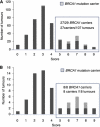Morphological predictors of BRCA1 germline mutations in young women with breast cancer
- PMID: 21343941
- PMCID: PMC3065278
- DOI: 10.1038/bjc.2011.41
Morphological predictors of BRCA1 germline mutations in young women with breast cancer
Abstract
Background: Knowing a young woman with newly diagnosed breast cancer has a germline BRCA1 mutation informs her clinical management and that of her relatives. We sought an optimal strategy for identifying carriers using family history, breast cancer morphology and hormone receptor status data.
Methods: We studied a population-based sample of 452 Australian women with invasive breast cancer diagnosed before age 40 years for whom we conducted extensive germline mutation testing (29 carried a BRCA1 mutation) and a systematic pathology review, and collected three-generational family history and tumour ER and PR status. Predictors of mutation status were identified using multiple logistic regression. Areas under receiver operator characteristic (ROC) curves were estimated using five-fold stratified cross-validation.
Results: The probability of being a BRCA1 mutation carrier increased with number of selected histology features even after adjusting for family history and ER and PR status (P<0.0001). From the most parsimonious multivariate model, the odds ratio for being a carrier were: 9.7 (95% confidence interval: 2.6-47.0) for trabecular growth pattern (P=0.001); 7.8 (2.7-25.7) for mitotic index over 50 mitoses per 10 high-powered field (P=0.0003); and 2.7 (1.3-5.9) for each first-degree relative with breast cancer diagnosed before age 60 years (P=0.01).The area under the ROC curve was 0.87 (0.83-0.90).
Conclusion: Pathology review, with attention to a few specific morphological features of invasive breast cancers, can identify almost all BRCA1 germline mutation carriers among women with early-onset breast cancer without taking into account family history.
Figures


References
-
- Antoniou AC, Cunningham AP, Peto J, Evans DG, Lalloo F, Narod SA, Risch HA, Eyfjord JE, Hopper JL, Southey MC, Olsson H, Johannsson O, Borg A, Pasini B, Radice P, Manoukian S, Eccles DM, Tang N, Olah E, Anton-Culver H, Warner E, Lubinski J, Gronwald J, Gorski B, Tryggvadottir L, Syrjakoski K, Kallioniemi OP, Eerola H, Nevanlinna H, Pharoah PD, Easton DF (2008a) The BOADICEA model of genetic susceptibility to breast and ovarian cancers: updates and extensions. Br J Cancer 98(8): 1457–1466 - PMC - PubMed
-
- Antoniou AC, Hardy R, Walker L, Evans DG, Shenton A, Eeles R, Shanley S, Pichert G, Izatt L, Rose S, Douglas F, Eccles D, Morrison PJ, Scott J, Zimmern RL, Easton DF, Pharoah PD (2008b) Predicting the likelihood of carrying a BRCA1 or BRCA2 mutation: validation of BOADICEA, BRCAPRO, IBIS, Myriad and the Manchester scoring system using data from UK genetics clinics. J Med Genet 45(7): 425–431 - PubMed
-
- Antoniou A, Pharoah PD, Narod S, Risch HA, Eyfjord JE, Hopper JL, Loman N, Olsson H, Johannsson O, Borg A, Pasini B, Radice P, Manoukian S, Eccles DM, Tang N, Olah E, Anton-Culver H, Warner E, Lubinski J, Gronwald J, Gorski B, Tulinius H, Thorlacius S, Eerola H, Nevanlinna H, Syrjäkoski K, Kallioniemi OP, Thompson D, Evans C, Peto J, Lalloo F, Evans DG, Easton D (2003) Average risks of breast and ovarian cancer associated with BRCA1 or BRCA2 mutations detected in case series unselected for family history: a combined analysis of 22 studies. Am J Hum Genet 72(5): 1117–1130 - PMC - PubMed
-
- Apicella C, Dowty JG, Dite GS, Jenkins MA, Senie RT, Daly MB, Andrulis IL, John EM, Buys SS, Li FP, Glendon G, Chung W, Ozcelik H, Miron A, Kotar K, Southey MC, Foulkes WD, Hopper JL (2007) Validation study of the LAMBDA model for predicting the BRCA1 or BRCA2 mutation carrier status of North American Ashkenazi Jewish women. Clin Genet 72: 87–97 - PubMed
-
- Armes JE, Egan AJ, Southey MC, Dite GS, McCredie MR, Giles GG, Hopper JL, Venter DJ (1998) The histologic phenotypes of breast carcinoma occurring before age 40 years in women with and without BRCA1 or BRCA2 germline mutations: a population-based study. Cancer 83(11): 2335–2345 - PubMed
Publication types
MeSH terms
Grants and funding
LinkOut - more resources
Full Text Sources
Medical
Molecular Biology Databases
Research Materials
Miscellaneous

